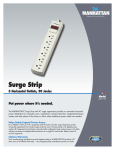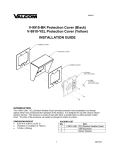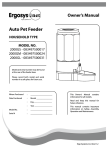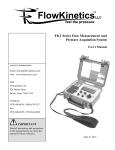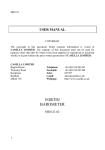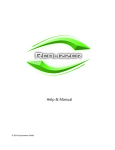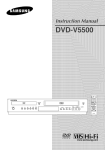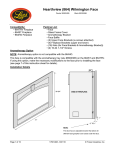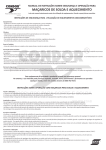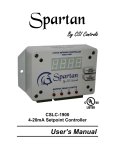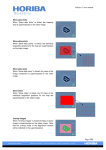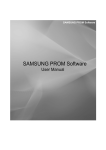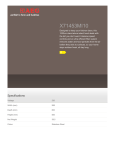Download AMETEK® PK II Pneumatic Deadweight Tester
Transcript
FORM 85-02 June 1999 Revision 6 AMETEK ® PK II Pneumatic Deadweight Tester Operating Instructions ® CALIBRATION INSTRUMENTS -1- TABLE OF CONTENTS Page 1.0 INTRODUCTION AND PRODUCT OVERVIEW ..................................................... 4 1.1 PRODUCT FEATURES ........................................................................................... 4 1.2 PK II PHYSICAL DIMENSIONS ............................................................................. 5 2.0 CORRECTION FACTORS ....................................................................................... 6 2.1 Corrections for Gravity ........................................................................................... 6 2.2 Corrections for Temperature ................................................................................... 7 2.3 Corrections for Air Head ......................................................................................... 8 3.0 RECOMMENDED RECERTIFICATION PROCEDURE ........................................... 8 3.1 Frequency of Certification ...................................................................................... 8 3.2 Materials Necessary for Recertification ................................................................. 8 4.0 SPECIFICATIONS ................................................................................................... 9 5.0 ASSEMBLY AND SETUP ......................................................................................... 13 5.1 Ball and Nozzle ........................................................................................................ 13 5.1.1 Removing the Nozzle .............................................................................................. 13 5.1.2 Removing the Ball ................................................................................................... 13 5.1.3 Cleaning the Ball and Nozzle ................................................................................... 13 5.1.4 Cleanliness Check .................................................................................................. 13 5.2 Leveling the Tester .................................................................................................. 13 5.2.1 Fast Leveling ........................................................................................................... 13 5.2.2 Fine Leveling ........................................................................................................... 13 5.3 Connection .............................................................................................................. 14 6.0 OPERATING INSTRUCTIONS ................................................................................ 15 7.0 MAINTENANCE ....................................................................................................... 16 7.1 Output System ........................................................................................................ 16 7.2 Input System ........................................................................................................... 17 -2- TABLE OF CONTENTS Page 8.0 TROUBLESHOOTING ............................................................................................ 18 8.1 Correcting For Poor Weight Rotation ...................................................................... 18 8.2 Output and Internal Leakage ................................................................................... 18 Output Connection Leakage ............................................................................. 18 8.2.1 8.2.2 Internal Leakage Within the Tester ................................................................... 18 8.3 Replacing the Nozzle and O-Ring ............................................................................ 18 9.0 PARTS LIST ............................................................................................................. 19 TABLES Page 2a Pressure in PSIG ..................................................................................................... 9 2b Pressure in Inches of Water @ 20°C ..................................................................... 10 2c Pressue in Grams per Square Centimeter .............................................................. 10 2d Pressure in Kilopascals ........................................................................................... 11 2e Pressure in Centimeters of Water @ 20°C ............................................................ 11 2f Pressure in Bar ........................................................................................................ 12 2g Pressure in Millimeters of Mercury ......................................................................... 12 PRODUCT WARRANTY This instrument is warranted against defects in workmanship, material and design for one (1) year from date of delivery to the extent that AMETEK will, at its sole option, repair or replace the instrument or any part thereof which is defective, provided, however, that this warranty shall not apply to instruments subjected to tampering or abuse, or exposed to highly corrosive conditions. THIS WARRANTY IS IN LIEU OF ALL OTHER WARRANTIES WHETHER EXPRESS OR IMPLIED AND AMETEK HEREBY DISCLAIMS ALL OTHER WARRANTIES, INCLUDING, WITHOUT LIMITATION, ANY WARRANTY OF FITNESS FOR A PARTICULAR PURPOSE OR MERCHANTABILITY. AMETEK SHALL NOT BE LIABLE FOR ANY INCIDENTAL OR CONSEQUENTIAL DAMAGES INCLUDING, BUT NOT LIMITED TO, ANY ANTICIPATED OR LOST PROFITS. This warranty is voidable if the purchaser fails to follow any and all instructions, warnings, and cautions in the instrument’s Instruction Manual. If a manufacturing defect is found, AMETEK will replace or repair the instrument or replace any defective part thereof without charge; however, AMETEK’s obligation hereunder does not include the cost of transportation which must be borne by the customer. AMETEK assumes no responsibility for damage in transit, and any claims for such damage should be presented to the carrier by the purchaser. -3- 1.0 INTRODUCTION AND PRODUCT OVERVIEW The AMETEK® PK II Pneumatic Deadweight Tester is a primary standard that produces a pressure by applying force (weight set) over area (the ceramic ball and nozzle). The PK II tester is NIST traceable and accurate to +0.015% of indicated reading using stainless steel weights calibrated to international standard gravity at 980.665cm/sec2. The unit is intended for low pressure applications up to 30 PSIG (2 bar). The PK II tester may also be calibrated to the user’s local gravity or to inches or centimeters of H2O at 20°C per ISA recommended practices, or to reference water columns at 60°F per AGA standard practices. The PK II tester is self-regulating with accuracy independent of the operator. The tester utilizes a frictionless ceramic ball which floats on a layer of air within a stainless steel cylinder. The PK II tester features a sturdy cast-metal base with integral quick-leveling system for field or laboratory use. The case also contains a tripod fixture allowing the unit to be tripod mounted in the field. 1.1 PRODUCT FEATURES The key features of the PK II Pneumatic Deadweight Tester are: G G G G G G G G G Accuracy up to +0.015% of indicated reading Floating ball operation eliminates need to rotate weights during testing Self regulating input air flow maintains ball and weights in a float position and compensates for variations in air supply pressure Rugged ceramic measuring ball withstands harsh environments and field use Monocontaminating fluid eliminates the need to clean instruments after calibration or before use Close cover operation eliminates wind effects in field calibrations Multi-position ball valves for both the inlet and outlet connections ensures trouble-free operation Certificate of Accuracy and Traceability available with area, mass and intrinsic correction factors Rugged aluminum housing offers long life. Top (Front) housing is reversible. -4- 1.2 PK II PHYSICAL DIMENSIONS 8.875 in 225.4 mm 12.75 in 323.85 mm 6.125 in 155.56 mm 3.0 in 76.2 mm Figure 1.1 PK II Dimensions (Models 104, 254, 304 and Medical) -5- PK II PHYSICAL DIMENSIONS 8.0 in 203.2 mm 12.75 in 323.85 mm 1.2 12.875 in 327.03 mm Figure 1.2 PK II Dimensions (Models 20SS, 30SS, 654, 854, 2000GM, 2010GM 200N, 201N, 500CM, 1000CM, 1500CM, 2000CM, 2B, 2B01) -6- 2.0 CORRECTION FACTORS An error in pressure determinations may result from any uncertainty of the mass of the loading weights and from the measurement of the effective area of the ball and nozzle. Other sources of error, however, may not be easily recognized. Other sources of error include the air buoyancy of the weights, gravity, thermal expansion and elastic deformation of the ball and nozzle, and the air heads involved. All of these corrections, with the exception of local gravity (except when specified), thermal expansion, and air heads have been corrected for by AMETEK prior to the tester being shipped. The following technique is suggested to compute the corrected tester output pressure readings: Gravity Local gravity values differ depending upon geographic locations. Pressure is defined as “force per unit area”, so that mass values must be converted to force values. To accomplish this, the acceleration of gravity must be used. The acceleration of local gravity may be determined by having a gravitational survey made of the local area with a gravimeter or by contacting various governing bodies such as the National Oceanic and Atmospheric Administration, U.S. Department of Commerce. Once the local value of gravity is known, the pressure may be corrected using the following formula: PG = G x P N GW Where: PG = tester output pressure corrected only for gravity G = local gravity GW = gravity value for which the tester is calibrated PN = pressure value of weights applied -7- Temperature If the coefficient of expansion of the ball and nozzle is positive, the effective area will increase with increasing temperature resulting in a corresponding decrease in pressure. Corrections can be made using the following formula: PT = PG 1 + 1.67 x 10-5 (T - 23°C) Where: PG = tester output pressure corrected only for gravity PT = tester output pressure corrected for gravity and temperature T = ambient temperature (°C) Air Head When pressurized, a correction is required only when the gauge height or reference plane of the unit being calibrated is either higher or lower than that of the pneumatic tester. The reference plane of the tester is at the top of the nozzle. Heights above the reference plane are negative, while heights below the reference plane are positive. Corrections can be made using the following formula: PA = PT (1 + H x 2.84 x 10-6) Where: H = air head (Inches) PT = tester output pressure corrected for gravity and temperature P = tester output pressure corrected for gravity, temperature and air head A -8- 3.0 CALIBRATION AND RECERTIFICATION The accuracy of measurements can only be ensured through calibration against reference standards of a known and well characterized measurement uncertainty; reference standards that are ultimately traceable through a national standards laboratory to the International Bureau of Weights and Measures (BIPM), to a natural physical constant, or to consensus standards. All AMETEK pressure calibrations are traceable in the United States of America to reference masters calibrated by the National Institute of Standards and Technology (NIST). Measurement performance is affected by the frequency and severity of use, the environment, test conditions, and by other factors. AMETEK recommends calibration on a prescribed interval/frequency in order to ensure optimal measurement performance and reliability. Two types of calibration services are offered: G Calibration with a Certificate of Conformance/Certificate of Compliance A statement of conformity which documents that the listed device(s) conforms to published specifications, or the terms of the order/contract. It can provide, in addition, a statement of traceability to NIST. G Calibration with a Calibration Report/Certificate A report that outlines detailed information about the calibration process. This includes actual calibration data, traceability information, test conditions, and other factors as may be applicable to the type of device being calibrated. 3.1 RECOMMENDED CALIBRATION FREQUENCY As a general rule, AMETEK pneumatic testers should be tested and recertified every 12 months. Testers used on a more frequent basis should be tested more frequently. 3.2 MATERIALS NECESSARY FOR RECERTIFICATION Both the tester assembly and weight set should be returned to AMETEK in order to allow for calibration of the tester as a “system”. Pressure is a derived parameter requiring determinations of both effective area and force (weight-mass). Instruments not sent to AMETEK as a “system” can only be provided with certifications on the parameter calibrated, e.g. effective area or mass. All materials should be securely packaged to prevent damage during transportation and handling. Testers should be returned in their case. The ball/nozzle assembly should be wrapped with adequate padding material and well secured to avoid shifting, movement and to protect them from shock during transportation. -9- 4.0 SPECIFICATIONS The PK II Pneumatic Deadweight Testers are self-regulating, primary standards with a pressure capacity of 104- 254-, 304- and 854-inches H2O. These instruments operate on the deadweight principle using only fundamental units of force and area. Pressure equals the weight force divided by the effective area of the ball. All PK II Testers are shipped with tester and weight contained within a carrying case. The instrument is available with accuracies of +0.015%, +0.025% or +0.05% of indicated reading with stainless steel weights. RANGE MINIMUM INCREMENT WEIGHT SET 1-20 PSIG 1 PSIG Table 2a PK2-30SS 1-30 PSIG 1 PSIG Table 2a PK2-104WC-SS 4-100” H2O 1” H2O Table 2b PK2-254WC-SS 4-254” H2O 1” H2O Table 2b PK2-304WC-SS 4-304” H2O 1” H2O Table 2b PK2-654WC-SS 4-654” H2O 1” H2O Table 2b PK2-854WC-SS 4-854” H2O 1” H2O Table 2b PK2-2000GM-SS 25 - 2000 gm/cm2 25 gm/cm2 Table 2c PK2-2010GM-SS 10 - 2000 gm/cm2 5 gm/cm2 Table 2c Table 2d MODEL PK2-20SS PK2-200N-SS 2-200 KPa 2 KPa PK2-201N-SS 1 - 200 KPa 0.5 KPa Table 2d PK2-500CM-SS 10 - 500 cm H2O 10cm H2O Table 2e PK2-100CM-SS 10 - 1000 cm H2O 10 cm H2O Table 2e PK2-1500CM-SS 10-1500 cm H2O 10 cm H2O Table 2e PK2-2000CM-SS 10 - 2000 cm H2O 10 cm H2O Table 2e PK2-2B-SS 0.02 - 2 bar 0.02 bar Table 2f PK2-SB .01-SS 0.01 - 2 bar 0.005 bar Table 2f PK2-MEDICAL 10 - 325 mm Hg 5 mm Hg Table 2g Table 2a Pressure in PSIG WEIGHT CARRIER AND BALL (PSIG) 1 PSI 2 PSI PK2-20SS 1 2 1 3 PK2-30SS 1 2 1 5 K-2000 (PK2-20, PK2-30) K-2011 MODEL Part Number - 10 - Weights Furnished per Pressure Increment 3 PSI 5 PSI K-2012 K-2013 K-2013-5 Table 2b Pressure in Inches of Water @ 20°C MODEL PK2-104WC-SS WEIGHT CARRIER AND BALL (in H2O) 1” H2O 2” H2O 4” H2O 1 4 Weights Furnished per Pressure Increment 5” H2O 10” H2O 20” H2O 50” H2O 100” H2O 11 9 - 11 - PK2-254WC-SS 4” H2O 1 2 1 2 1 2 PK2-304WC-SS 4” H2O 1 2 1 2 1 1 2 PK2-654WC-SS 4” and 10” H2O 1 2 1 2 1 2 5 PK2-854WC-SS 4” and 10” H2O 1 2 1 2 1 2 7 Part Number K-1279 (4” H2O) K-1277 K-1278 K-2047-1 K-1294 K-2046-16 K-2030 K-2031 K-1265-1 (10” H2O) NOTE: 1 1 Weight insert accepts optional 100” H2O weight. Table 2c Pressure in Grams per Square Centimeter (g/cm 2 ) MODEL WEIGHT CARRIER AND BALL (g/cm2) PK2-2000GM-SS 25g/cm2 PK2-2010GM-SS 25 and 10g/cm2 Part Number Weights Furnished per Pressure Increment 5g/cm2 10g/cm2 1 2 25g/cm2 50g/cm2 100g/cm2 200g/cm2 500g/cm2 1 1 2 1 3 1 1 2 1 3 K-1279-4 (10g/cm2) K-1265-13 (25g/cm2) K-2047-33 K-2047-32 K-2046-30 K-2046-19 K-2030-5 K-2039-14 K-2039-11 Table 2d Pressure in Kilopascals (KPa) MODEL WEIGHT CARRIER AND BALL (KPa) PK2-200N-SS 2 KPa PK2-201N-SS 2 KPa & 1 KPa Part Number Weights Furnished per Pressure Increment 0.5 KPa 1 KPa 1 1 2 KPa 4 KPa 10 KPa 20 KPa 50 KPa 2 1 2 1 3 2 1 2 1 3 K-1279-2 (1KPa) K-1265-12 (2 KPa) K-2047-17 K-2047-18 K-1294-2 K-2046-29 K-2030-1 K-2031-3 K-2039-12 - 12 Table 2e Pressure in Centimeters of Water @ 20°C MODEL PK2-500CM-SS WEIGHT CARRIER AND BALL (cm H2O) 10cm H2O 10 cm H2O 1 Weights Furnished per Pressure Increment 20cm H2O 2 50cm H2O 1 100cm H2O 200cm H2O 500cm H2O 2 1 PK2-1000CM-SS 10 cm H2O 1 2 1 2 1 1 PK2-1500CM-SS 10 and 25 cm H2O 1 2 1 2 1 2 PK2-2000CM-SS 10 and 25 cm H2O Part Number 1 2 1 2 1 3 K-2047-24 K-2045-10 K-2046-24 K-2031-18 K-2031-19 K-2031-20 Table 2f Pressure in Bar MODEL WEIGHT CARRIER AND BALL (Bar) PK2-2B-SS 0.02 Bar PK2-.01-SS 0.01 and 0.02 Bar Part Number Weights Furnished per Pressure Increment 0.005 bar 0.01 Bar 0.02 Bar 0.04 Bar 0.1 Bar 2 1 2 1 3 1 1 2 1 2 1 3 K-2047-17 K-2047-18 K-1294-2 K-2046-29 K-2030-1 0.2 Bar 0.5 Bar K-2031-3 K-2039-12 - 13 Table 2g Pressure in Millimeters of Mercury (Hg) MODEL WEIGHT CARRIER AND BALL (mm Hg) PK2-MED 10 mm Hg Part Number Weights Furnished per Pressure Increment 5 mm Hg 10 mm Hg 20 mm Hg 50 mm Hg 100 mm Hg 1 2 2 1 2 K-2047-23 K-2047-22 K-2046-25 K-2046-21 K-2012-1 5.0 ASSEMBLY AND SETUP 5.1 BALL AND NOZZLE You should routinely check the ceramic ball and the nozzle for cleanliness. Never scrape the nozzle or its associated parts with a hard object or anything that is abrasive or that may remove material from the parts. AMETEK recommends that the ceramic ball and nozzle be kept in place at all times, except when cleaning is required. This will prevent dirt from entering the ball and nozzle assembly. 5.1.1 Removing Ceramic Ball Cup one hand over the top (beveled end) of the nozzle and push from the bottom of the nozzle to remove the ball. If the ball tends to stick when being removed, DO NOT FORCE IT. Forcing the ball may cause serious damage to the nozzle. Carefully, lift the ceramic ball from the nozzle assembly and store in a secure location. 5.1.2 Removing the Nozzle Carefully remove the nozzle by pulling the nozzle upward while twisting to overcome the friction of the O-ring seal. Grasp the nozzle firmly and pull upward with a slight twisting motion. - 14 - 5.1.3 Cleaning Ball and Nozzle AMETEK recommends cleaning the ceramic ball and nozzle with a residue-free solvent. Using a cottom swab or soft cloth with a solvent such as alcohol, wipe the inside of the nozzle. Dampen a clean cloth with alcohol or other residue-resistant solvent, and clean the ceramic ball by rotating it within the cloth. 5.1.4 Ball & Nozzle Cleanliness Check The ball should pass smoothly through the nozzle bore without any restriction or friction. If resistance is felt, reclean the ceramic ball and nozzle and repeat cleanliness check. After the ball and nozzle have been cleaned, slide the ball through the nozzle. The ball should pass through the nozzle with no resistance. - 15 - 5.1.4 Ball & Nozzle Reassembly After ensuring that both the ceramic ball and nozzle are clean, reassembly by first placing the nozzle back into proper position and alignment. Always make sure that the serial number on the nozzle is directly above the serial number of the nozzle body. CORRECT ALIGNMENT- The serial number for the nozzle (top) aligns with the serial number of the nozzle body (bottom). INCORRECT ALIGNMENT- The serial numbers DO NOT align and may lead to inaccurate readings. - 16 - 5.2 LEVELING THE TESTER For proper operation, the PK II tester should be placed on a support that is solid and free from vibration. 5.2.1 Coarse Leveling Both coarse and fine leveling are supported by the PK II tester. Coarse leveling to raise the tester is achieved by pushing the knurled rod (located inside the case on either side of the weight insert) and rotating the knurled nut until it contacts the bottom of the case. For coarse adjustment, use the knurled rod located on the top. 5.2.2 Fine Leveling Fine leveling is obtained by rotating the knurled rod clockwise to raise and counterclockwise to lower the tester. A third adjustable foot is located under the PK II case between the inlet and outlet valves. A bull’s-eye level is located on the cover plate for sighting level accuracy. For fine adjustment, hold the bottom foot and rotate the knurled knob at the top. - 17 - 5.3 CONNECTION Connect a supply of clean, dry and oil-free air or nitrogen to the connection below the valve marked “INLET”. CAUTION The use of other gases will result in an incorrect reading. Always use clean, dry and oil-free air or nitrogen. When using the tester thru full range, regulate the supply pressure at 30 PSIG minimum, however take care NOT TO REGULATE THE SUPPLY PRESSURE OVER 100 PSIG. WARNING Do not regulate the supply pressure over 100 PSIG. Connect clean, dry and oil-free air or nitrogen to the INLET valve. Connect instrument to be tested to the OUTLET valve. Connect the instrument to be tested to the valve marked “OUTLET”. The tester’s input and output connections are 1/4-inch male tube fittings. The accuracy of the tester is seriously undermined by leaks in the output connections and/or the instrument being calibrated. To check for leaks, load the tester so as to apply a pressure indicating instrument and then turn off the tester output valve. If the pressure indicated by the instrument being calibrated holds, it is safe to assume their are no leaks. If, however, the pressure decreases, there is likely a leak in the calibration system. You must locate and fix the leak before calibration can take place. Under no circumstances should mercury or corrosive fluids be permitted into the tester. When the tester is used in connection with an instrument or pressure system that contains a liquid, a suitable safeguard such as a trap or float-type manometer check valve should be installed in the tester output line to prevent fouling of tester components. - 18 - 6.0 OPERATING INSTRUCTIONS The following steps are provided to guide the user through a typical calibration using the PK II tester. Step 1 Slip the weight carrier over the ceramic ball. Slide the weight carrier over the ball and nozzle assembly. Step 2 Admit the supply pressure to the tester by turning on the valve marked “INLET”. WARNING NEVER connect the PK II tester to a high pressure source. Applying high pressure may result in personal injury and damage to the tester. NEVER apply a pressure greater than 100 PSIG. Open the INLET valve and supply pressure to the tester. Step 3 Add weights as required. Exercise caution when handling the weights. Handle only one weight at a time to avoid damaging the weights. Add the required weights by sliding the weights over the carrier. Apply the heavier weights first. Always store the weights in the compartment provided in the PK II tester case. - 19 - 6.0 OPERATING INSTRUCTIONS (Cont’d.) Step 4 Weights may be given a slow rotary motion to ensure that the weights rotate freely without abrupt stopping. (See Section 6.1 to correct for poor weight rotation). Note: It is not necessary to excessively spin the weights of the pneumatic deadweight tester to overcome friction. Excessive rotation may affect accuracy. WARNING Do NOT spin the weights unless the ceramic ball is floating. Slowly rotate the weights to ensure that there are no restrictions and that the weights float freely. Step 5 Open the tester “OUTLET” valve and calibrate the instrument. Once calibration is complete, the downstream pressure may be vented by turning the outlet valve to the “VENT” position. Open the OUTLET valve to calibrate the instrument. Once the calibration is completed, you may vent the pressure by rotating the OUTLET knob to the VENT position. CAUTION The ceramic ball, weight carrier and weights comprise a “system” for your PK II calibrator and should be used together to ensure a correct calibration. Accuracy will be affected if the ceramic ball, weight carrier and weights are interchanged. - 20 - 7.0 MAINTENANCE 7.1 OUTPUT SYSTEM The PK II tester features an output tank that may be cleaned. If any contamination is evident in the output system, it may be easily removed using the following procedure: Step 1 Remove the weights and weight carrier from the tester leaving the ceramic ball in place. Step 2 Connect an air supply to the tester. Step 3 Disconnect the output line. - 21 - Step 4 Fully open both the INLET and OUTLET valves. Step 5 While holding the ceramic ball (to ensure that the ball does not fall out), tilt the tester so that the output connection is pointing downward. Step 6 Pressure the ball into its socket to provide an output pressure sufficient to purge the system. Step 7 After completing Steps 1 - 6, disconnect the air supply from the INLET and connect the air supply to the OUTLET. DO NOT APPLY PRESSURE AT THIS TIME. Step 8 Using a screw driver, remove the ceramic ball and restriction tube. The restriction tube is located under the ceramic ball. - 22 - Step 9 Remove the nozzle. Step 10 Place a cloth or absorbent material over the nozzle body. Step 11 Apply 15 to 30 PSI to the OUTLET for a few seconds or until the material on the nozzle body is clean and dry when removed. Mild solvents may be applied to the outlet fitting and flushed out when applying pressure. If a solvent is used, it should not leave any film or residue once dried. Step 12 Clean the output restriction using a 1/32” drill or piece of 22 gauge wire to clean out any obstructions. Step 13 Clean the ceramic ball, nozzle and body thoroughly. - 23 - 7.2 INPUT SYSTEM The PK II tester features an input filter located within the 1/4” male tube fitting on the outside of the PK II tester case. As this filter becomes dirty, the tester may react by not supporting the weights. To correct, remove the filter and examine the NPT opening for any contamination. CLEANING THE INPUT FILTER Remove the input filter fitting and clean it by backflushing from the downstream end with clean compressed air. If an ultrasonic cleaner is available, AMETEK recommends that the filter fitting be cleaned using the ultrasonic cleaner for 10 to 15 minutes in a residue-free solvent. CAUTION Do NOT attempt to remove the filter element from the fitting. Filters should be replaced periodically. - 24 - 8.0 TROUBLESHOOTING The following represent common troubleshooting tips for the PK II tester. 8.1 CORRECTING FOR POOR WEIGHT ROTATION If weights do not rotate freely as described in Section 6.0, Step 4, perform the following: Step 1 Check the cleanliness of the ceramic ball and nozzle. Step 2 Make sure the tester is level by checking the bull’s eye. Step 3 Isolate tester from environmental vibrations or relocate tester. Step 4 Check for adequate air supply. 8.2 OUTPUT AND INTERNAL LEAKAGE The accuracy of the tester is seriously undermined by leaks in the output connections and/ or instrument being calibrated. The following procedures are recommended to isolate and correct for leakage. 8.2.1 Output Connection Leaks Load the tester so as to apply a pressure to the instrument being calibrated. Close (turn OFF) the OUTLET valve. If the pressure indicated by the instrument being calibrated remains constant (holds at the indicated pressure), it is safe to assume there are no leaks in the output system (between the tester and the instrument). - 25 - 8.2.2 Internal Leaks You can perform a check for internal leaks with the input pressure applied and with the cover plate off. Step 1 Place full range of weights onto tester. Step 2 Turn OFF (Close) the OUTPUT valve. Step 3 Apply liquid leak detector to all internal fittings from the input connection to the output valve. Step 4 Check for leaks by the presence of bubbles on joints. Step 5 If a leak is found, the PK II Tester must be returned to AMETEK for repair. WARNING Leak checks should be done in the order described above, otherwise the source of the leak may not be accurately identified. CAUTION DO NOT ATTEMPT TO REPAIR INTERNAL LEAKS. Return the PK II tester to AMETEK for internal leak repairs. Failure to do so may void product warranty. 8.3 REPLACING THE NOZZLE AND O-RING Remove the ball and nozzle and the nozzle O-ring (10-90013). The replacement O-ring should be wiped clean with a lint-free cloth and placed within the groove in the nozzle body. DO NOT LUBRICATE THE O-RING WITH ANY FORM OF OIL OR GREASE. Clean the ball and nozzle as described in Section 5.1.3.- Cleaning the Ball and Nozzle, and reassemble. - 26 - 9.0 PARTS LIST PART NUMBER K-1035 K-1048 K-1050/ETCH 10-90013 K-1051 K-1182 K-1193 K-1209 K-1212 K-1216 K-1217 K-1223 K-1224 K-1246 K-1273 K-1297 K-1303 K-1831 K-1832 K-1833 K-1834 K-1835 K-1836 K-1839 K-1840 K-1850 K-1868/ASSY K-1896/ASSY K-1880 K-1882 03-90020 04-90047 06-90040 12-90040 11-90062 13-90003 13-90022 DESCRIPTION Nameplate Nozzle Body Restriction Screw Nozzle Nozzle O-Ring Ceramic Ball Spring Retainer Regulator Nozzle Block Disc, Clip and Diaphragm Assembly Regulator Ratio Disc Diaphragm (Stem Side) Regulator Ratio Disc Diaphragm (Flat) Gasket Regulator Assembly Screw Bulls-Eye Level Label (Inlet, Outlet, Caution) Capacity Tank Assembly Nozzle Body Restriction Assembly Tripod Mounting Plate Level Adjust Stud Level Retainer Stud Leveling Foot Leveling Foot Assembly Aluminum Adjusting Nut (3/8”-24) Nut (5/8-18 x 1/8”) Regulator Assembly Filter Assembly Internal Cover Assembly (Small Case) Internal Cover Assembly (Large Case) Regulator Bracket Weight Retainer Block Screw (2-56 x 5/16) Nut (7/16-20) Brass Washer (0.74” OD) 1/8” NPT x 1/8” Tube Straight Connector Bulkhead Fitting Outlet Valve Inlet Valve - 27 - ® CALIBRATION INSTRUMENTS AMETEK Test and Calibration Instruments 8600 Somerset Drive Largo, Florida 33773 Tel +1 (727) 536-7831 Tel +1 (800) 527-9999 Fax +1 (727) 539-6882 AMETEK Precision Instruments Europe GmbH Rudolf-Diesel-Strasse 16 D-40670, Meerbusch Germany Tel +49 2159 9136 0 Fax +49 2159 9136 39 AMETEK Singapore Pvt. Ltd. 10 Ang Mo Kio Street 65 #05-12 TECHPOINT Singapore 569059 Tel +65 484 2388 Fax +65 481 6588 AMETEK Denmark A/S Gydevang 32-34 DK-3450 Allerod Denmark Tel Fax +45 4816 8000 +45 4816 8080 Internet Addresses: www.ametek.com Information within this document is subject to change without notice. ISO 9001 Manufacturer AMETEK is a registered trademark of AMETEK, Inc. Pub No. FORM 85-02 (Rev 6) Issued 06/99 Copyright 1999, by AMETEK, Inc. - 28 - Printed in U.S.A.




























